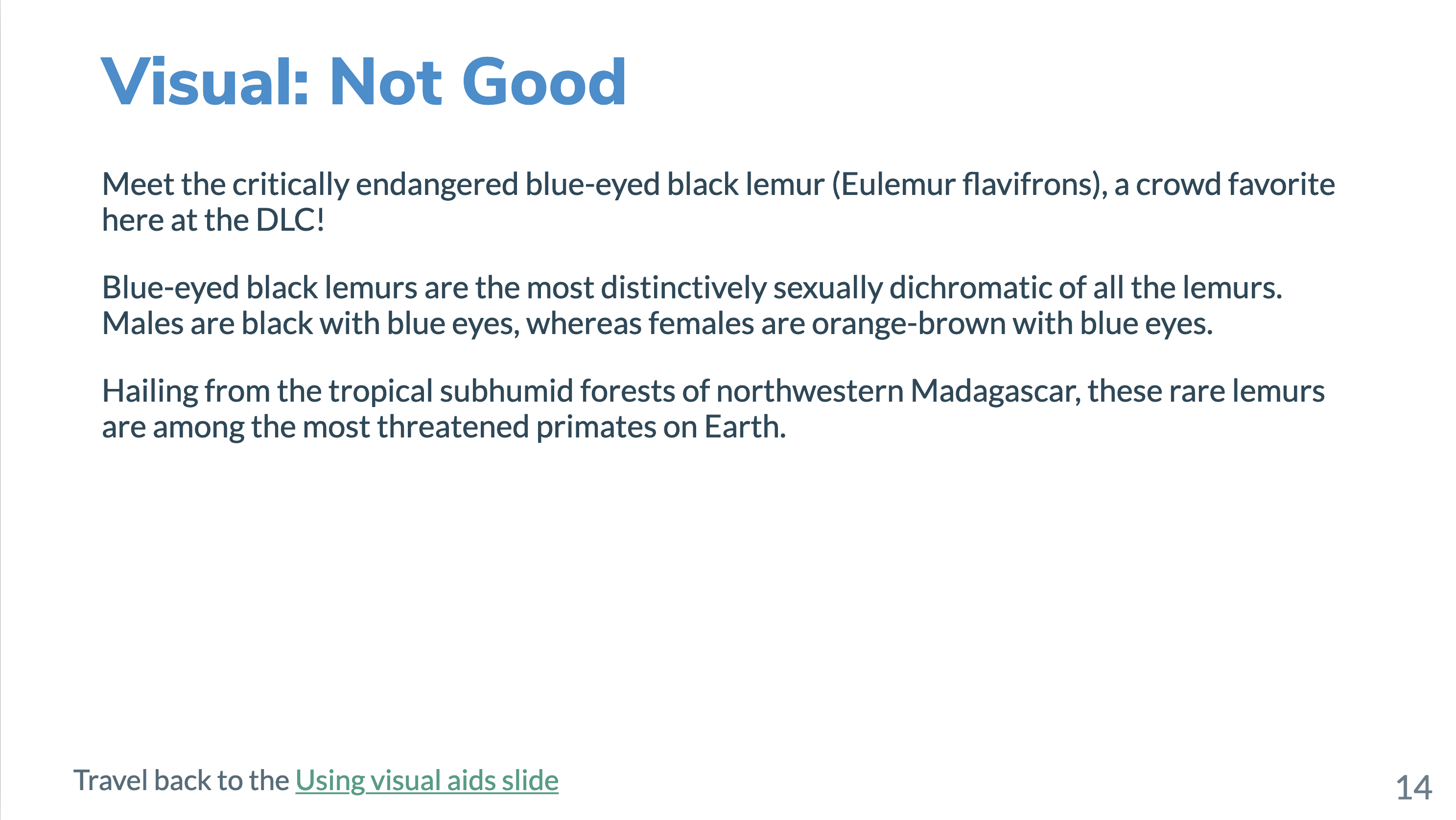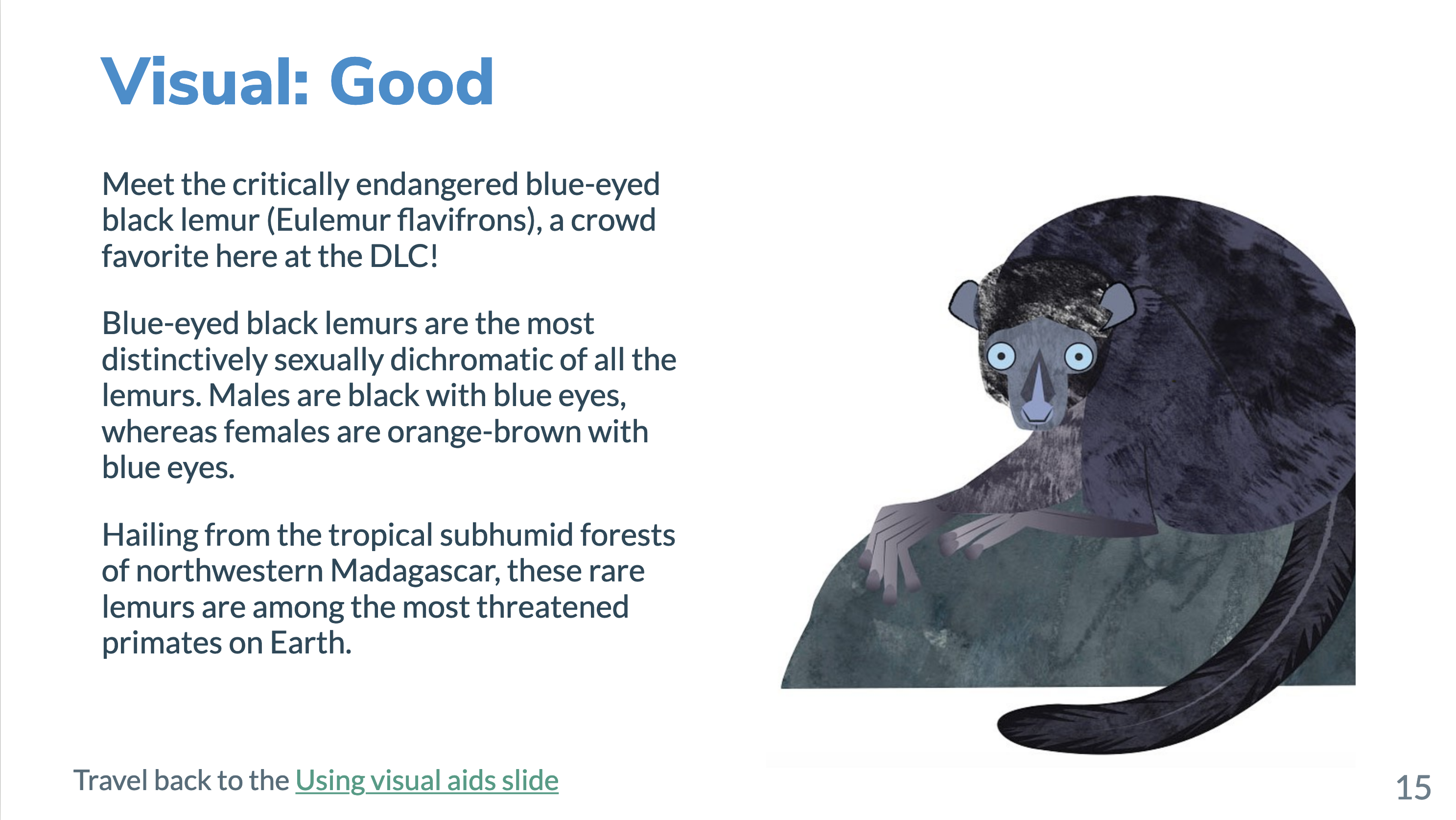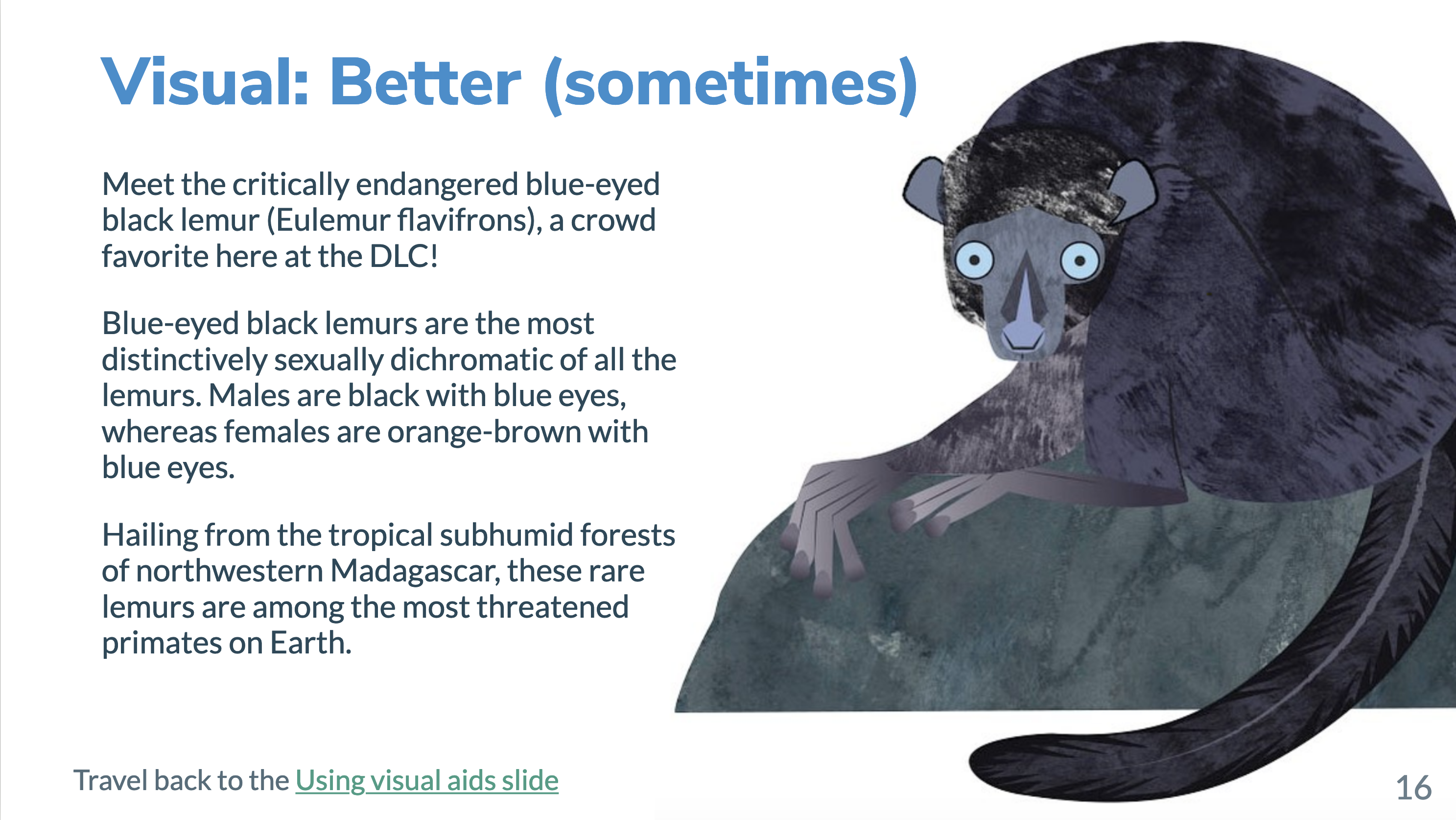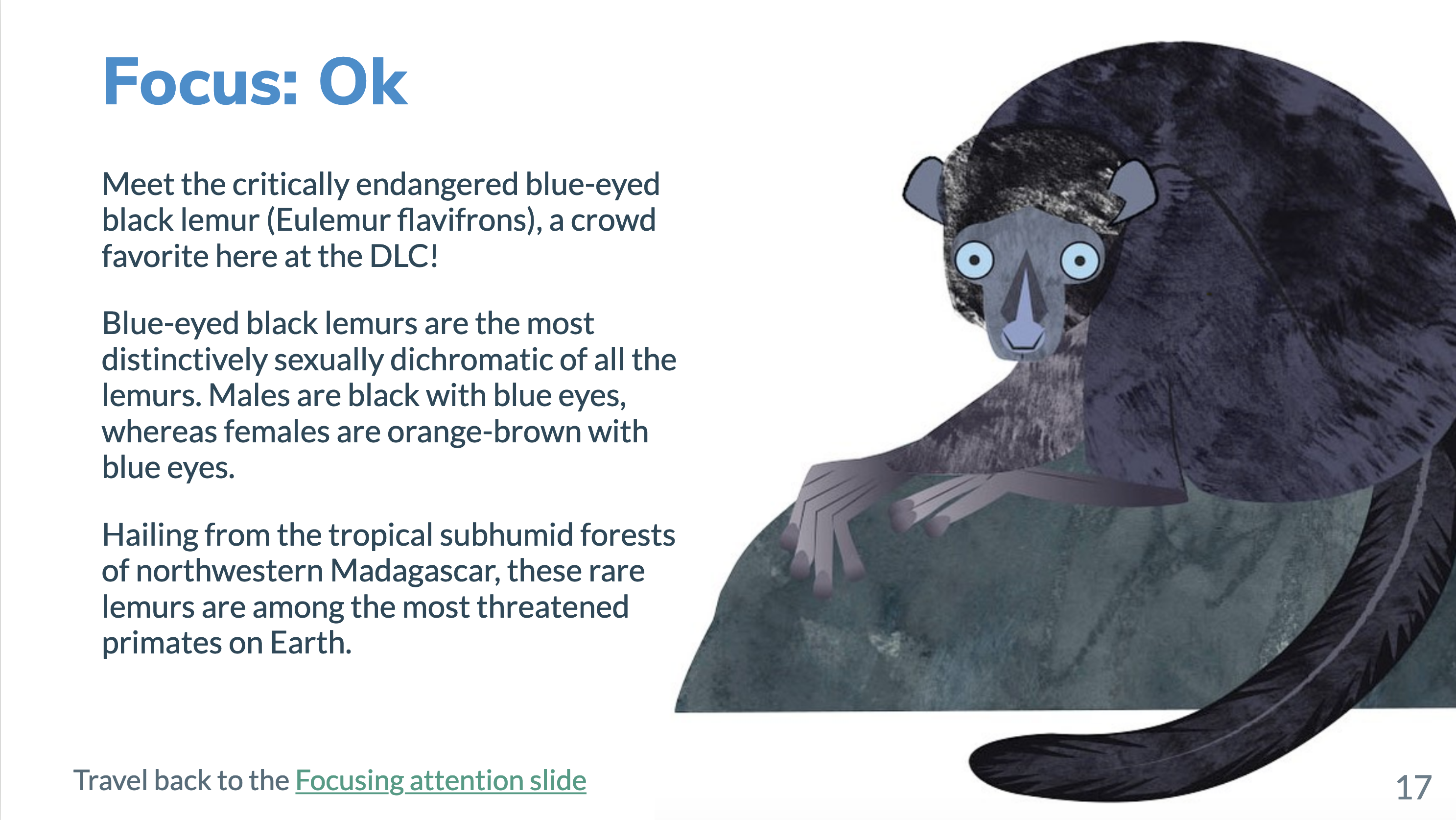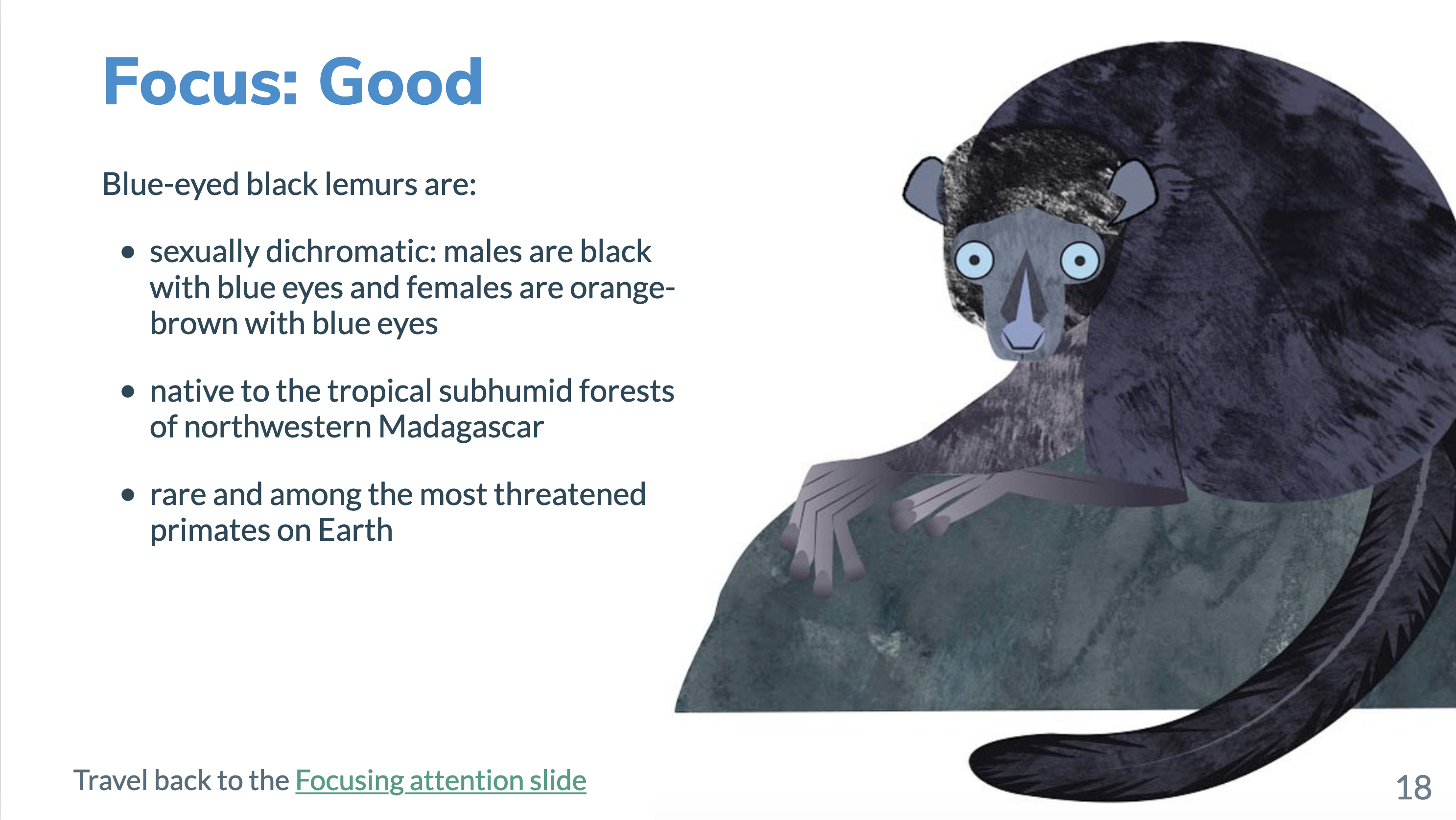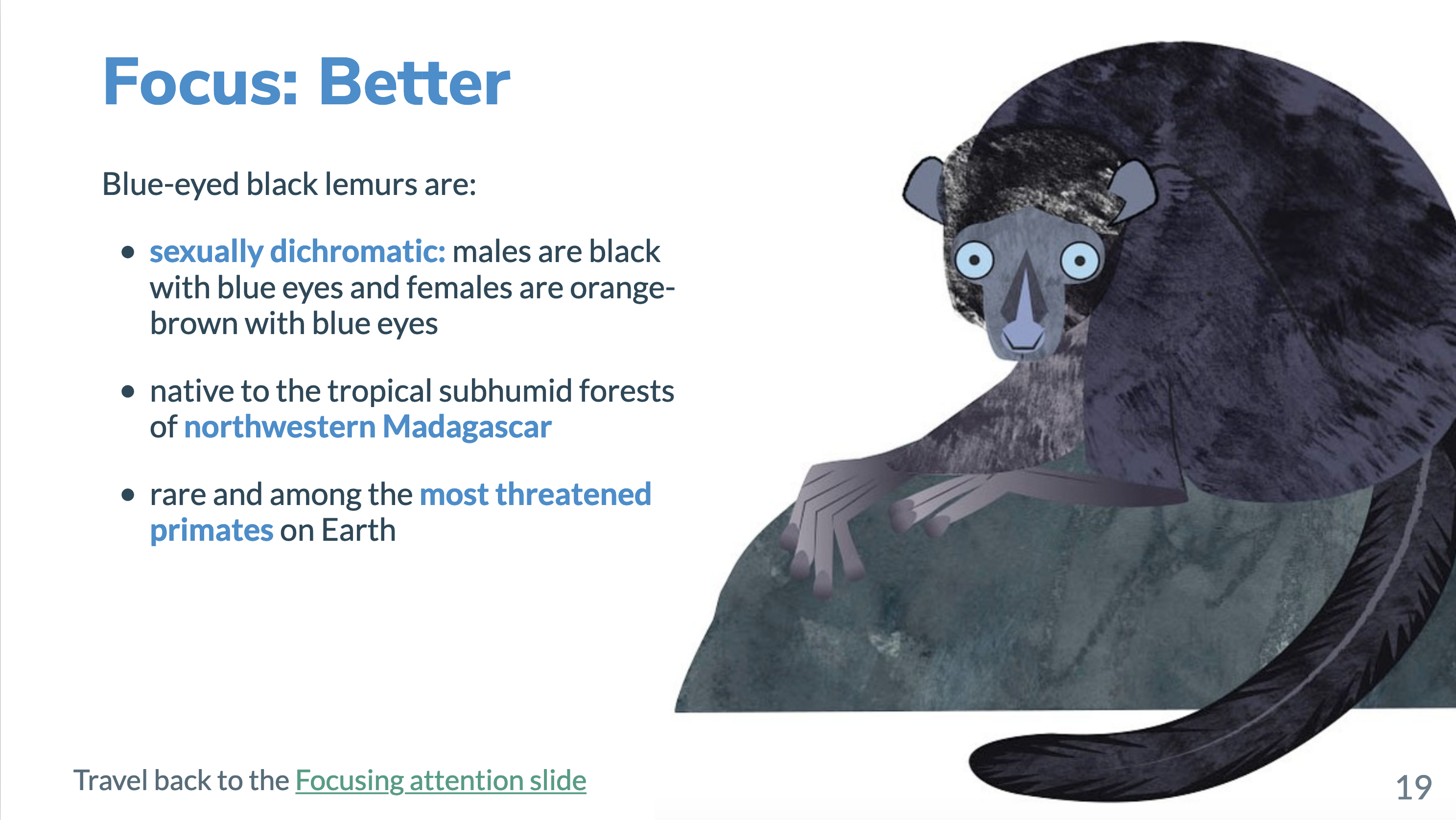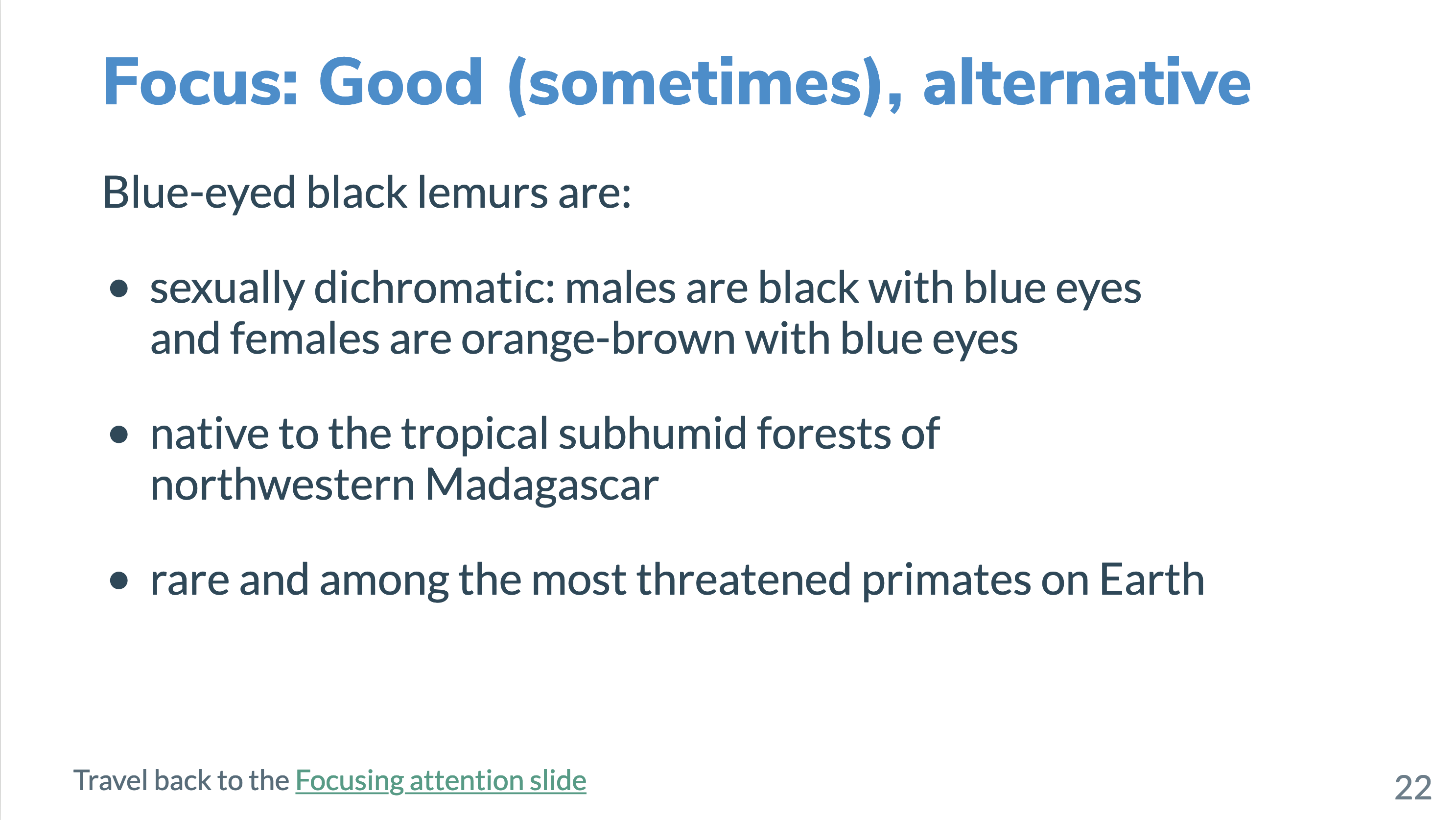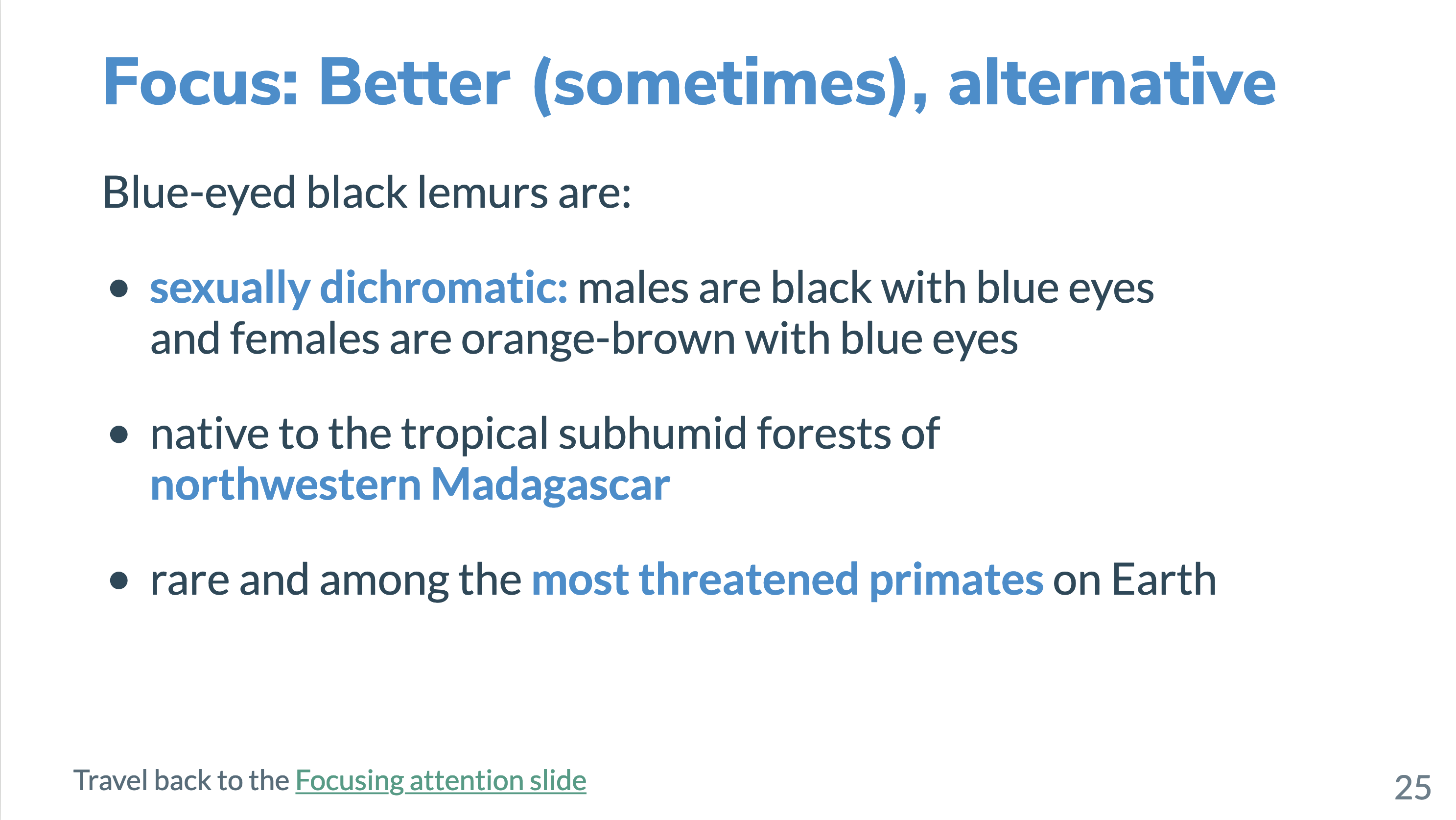Effective communication
has the power to:
- capture the attention of your audience
- convince others of your findings
- help you teach more effectively
- reach a broader audience
How does xaringan already help us build effective presentations?
Use the right markup for your presentation’s structure
Stick to widely used & open file formats
Make "accessible" your default mindset
Design for the mode of delivery
Use clear and simple figures and graphics
Write clearly
Guidelines from Making Scientific Content More Accessible
by Goring, Stack Whitney, Jacob, Bruna, and Poisot
Make "accessible"
your default mindset
We communicate effectively when we make our work open and accessible to a broad audience
Principles of inclusive design
- Recognize exclusion
- Solve for one, extend to many
- Learn from diversity
2.1 Make “accessible” your default mindset
Figure from the Inclusive Design 101 Toolkit by Microsoft
Recognizing exclusion helps us call on our humanity and powers of empathy
By designing for someone with a permanent disability, someone with a situational limitation can also benefit
By putting people at the center of our design process we learn from diverse perspectives and experiences
Design for the mode of delivery
Slide presentations require different design considerations than papers or posters
Design content with fewer and more focused details
We don't have to format a
slide presentation like a paper
Design tips:
Use context-relevant visual aids to help communicate your message
Focus attention and include only the most relevant details
Unify your content by maintaining consistency in layout and structure
2.2 Design for the mode of delivery
Better Presentations: A Guide for Scholars, Researchers, and Wonks by Jonathan Schwabish
In practice: Using visual aids
Avoid writing a "wall of text," break up the content
Add a visual aid if it will help carry the message
Turn your visual into a larger background image
If your text overlaps with the background image, consider using CSS styling to give your text a background for contrast
In practice: Focusing attention
Structure your text into smaller pieces and eliminate extra text
Emphasize important words or phrases with text formatting
Use incremental reveals to control the timing of content
- Note: Provide a version of your slides without
incremental reveals for screen readers users
- Note: Provide a version of your slides without
In practice: Unifying your content
Layout
Be consistent in your use of content classes
Place text and images consistently between slides
Balance content so that the slide is not too full
Structure
Use headings and lists to provide hierarchy and organization
Use color, font size, and
font type consistentlyUse a similar style or theme of images or photographs
Use clear and simple figures & graphics
Complex images and figures can be difficult for:
your audience to process during your presentation
you to describe out loud as you are presenting
you to describe with alternative text (alt-text)
2.4 Use clear and simple figures and graphics
complex images can direct the audience attention away from your main message
complex images are harder to describe with alt text, which is necessary to make the image accessible to screen readers
Write clearly
Engage a broad audience with clear language
Provide descriptive slide headings
Introduce and define abbreviations
Define field-specific terminology
Write to an audience outside of disciplinary
silos and even outside of academia
In practice: Writing clearly
From Web Accessibility in Mind
- 8th grade reading level if targeting a broad audience
- 12th grade level for an educated or specialized audience
From The A11Y Project
- Audience between the ages of 12 and 15 years old
Let's check the readability of our lemur content!
We are finished with this scene!
Use the right markup for your presentation’s structure
Stick to widely used & open file formats
Make "accessible" your default mindset
Design for the mode of delivery
Use clear and simple figures and graphics
Write clearly
materials/act-02/04-effective-communication
Visual: Not Good
Meet the critically endangered blue-eyed black lemur (Eulemur flavifrons), a crowd favorite here at the DLC!
Blue-eyed black lemurs are the most distinctively sexually dichromatic of all the lemurs. Males are black with blue eyes, whereas females are orange-brown with blue eyes.
Hailing from the tropical subhumid forests of northwestern Madagascar, these rare lemurs are among the most threatened primates on Earth.
Travel back to the Using visual aids slide
No use of slide or content classes
Demo
Use of name: visual-not-good
---name: visual-not-good<slide content>---The name can then be used for internal linking like in the slide that brought us to this one
[Example slide: not good](#visual-not-good)Visual: Good
Meet the critically endangered blue-eyed black lemur (Eulemur flavifrons), a crowd favorite here at the DLC!
Blue-eyed black lemurs are the most distinctively sexually dichromatic of all the lemurs. Males are black with blue eyes, whereas females are orange-brown with blue eyes.
Hailing from the tropical subhumid forests of northwestern Madagascar, these rare lemurs are among the most threatened primates on Earth.
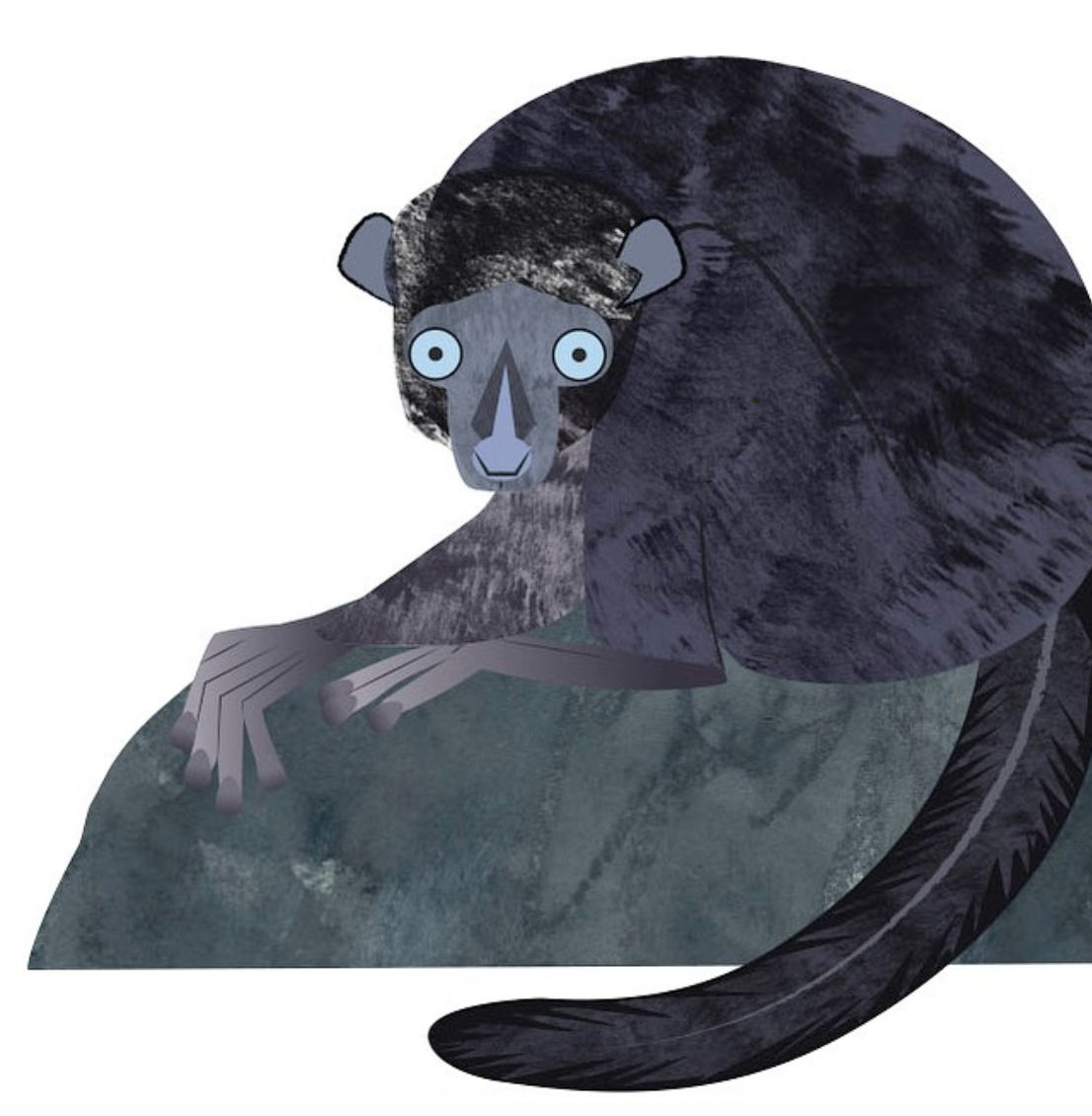
Travel back to the Using visual aids slide
.pull-left[]and.pull-right[]classesimage inserted with
knitr::include_graphics()fig.alt=code chunk
Visual: Better (sometimes)
Meet the critically endangered blue-eyed black lemur (Eulemur flavifrons), a crowd favorite here at the DLC!
Blue-eyed black lemurs are the most distinctively sexually dichromatic of all the lemurs. Males are black with blue eyes, whereas females are orange-brown with blue eyes.
Hailing from the tropical subhumid forests of northwestern Madagascar, these rare lemurs are among the most threatened primates on Earth.
Travel back to the Using visual aids slide
.pull-left[]and.pull-right[]classesimage inserted using:
background-image:url() background-position:rightbackground-size:contain
Focus: Ok
Meet the critically endangered blue-eyed black lemur (Eulemur flavifrons), a crowd favorite here at the DLC!
Blue-eyed black lemurs are the most distinctively sexually dichromatic of all the lemurs. Males are black with blue eyes, whereas females are orange-brown with blue eyes.
Hailing from the tropical subhumid forests of northwestern Madagascar, these rare lemurs are among the most threatened primates on Earth.
Travel back to the Focusing attention slide
.pull-left[]and.pull-right[]classesimage inserted using:
background-image:url() background-position:rightbackground-size:contain
Focus: Good
Blue-eyed black lemurs are:
sexually dichromatic: males are black with blue eyes and females are orange-brown with blue eyes
native to the tropical subhumid forests of northwestern Madagascar
rare and among the most threatened primates on Earth
Travel back to the Focusing attention slide
.pull-left[]and.pull-right[]classesimage inserted using:
background-image:url() background-position:rightbackground-size:contain
use of an unordered list with dashes
-
Focus: Better
Blue-eyed black lemurs are:
sexually dichromatic: males are black with blue eyes and females are orange-brown with blue eyes
native to the tropical subhumid forests of northwestern Madagascar
rare and among the most threatened primates on Earth
Travel back to the Focusing attention slide
.pull-left[]and.pull-right[]classesimage inserted using:
background-image:url() background-position:rightbackground-size:contain
use of an unordered list with dashes
-use of CSS classes to highlight text with a blue bold face
Focus: Good (sometimes), alternative
Blue-eyed black lemurs are:
- sexually dichromatic: males are black with blue eyes
and females are orange-brown with blue eyes
Focus: Good (sometimes), alternative
Blue-eyed black lemurs are:
- sexually dichromatic: males are black with blue eyes
and females are orange-brown with blue eyes
- native to the tropical subhumid forests of
northwestern Madagascar
Focus: Good (sometimes), alternative
Blue-eyed black lemurs are:
- sexually dichromatic: males are black with blue eyes
and females are orange-brown with blue eyes
- native to the tropical subhumid forests of
northwestern Madagascar
- rare and among the most threatened primates on Earth
Travel back to the Focusing attention slide
use of an unordered list with dashes
-incremental list items with
--separator
Focus: Better (sometimes), alternative
Blue-eyed black lemurs are:
- sexually dichromatic: males are black with blue eyes
and females are orange-brown with blue eyes
Focus: Better (sometimes), alternative
Blue-eyed black lemurs are:
- sexually dichromatic: males are black with blue eyes
and females are orange-brown with blue eyes
- native to the tropical subhumid forests of
northwestern Madagascar
Focus: Better (sometimes), alternative
Blue-eyed black lemurs are:
- sexually dichromatic: males are black with blue eyes
and females are orange-brown with blue eyes
- native to the tropical subhumid forests of
northwestern Madagascar
- rare and among the most threatened primates on Earth
Travel back to the Focusing attention slide
use of an unordered list with dashes
-incremental list items with
--separatoruse of CSS classes to highlight text with a blue bold face
